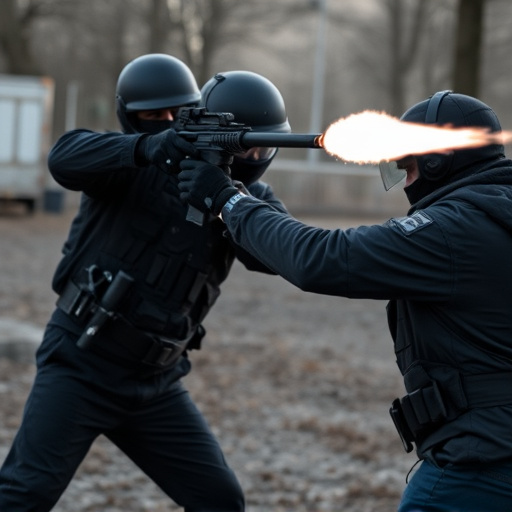High-powered stun guns, designed for temporary neuromuscular incapacitation through electric shock, have variable paralysis durations based on weapon model, distance, target's physical condition, and clothing. While law enforcement uses them as a last resort, the legal landscape surrounding their sale is complex, with stringent regulations to prevent misuse and protect public safety due to potential risks like prolonged immobilization, falls, and heatstroke. Responsible deployment requires extensive officer training in de-escalation tactics.
Paralysis induced by taser deployment is a complex issue with significant legal implications. This article delves into understanding the duration of paralysis following taser use, exploring various factors that influence its length. We discuss the effects of taser deployment and examine legal considerations surrounding high-powered stun guns available for sale in today’s market. By analyzing these aspects, we aim to provide insights into the potential consequences and responsible ownership of these powerful devices.
- Understanding Taser Deployment and Its Effects
- Factors Influencing Paralysis Duration
- Legal Considerations and High-Powered Stun Guns for Sale
Understanding Taser Deployment and Its Effects

Tasers, or electroshock weapons, are high-powered stun guns designed to temporarily incapacitate individuals through electric shock. When deployed, they fire two thin probes connected to wires, delivering a powerful electric current that disrupts the body’s neuromuscular system. This disruption leads to muscle contractions and paralysis, rendering the targeted person unable to move or resist for several seconds. The duration of this paralysis is a crucial aspect to consider when evaluating Taser deployment, as it directly impacts safety and the potential for harm.
The length of paralysis caused by a Taser can vary depending on factors such as the model of the weapon, the distance between the user and the target, and the individual’s physical condition. On average, the effects of a Taser stun typically last from several seconds up to 5 minutes or more. During this period, individuals may experience muscle rigidity, loss of balance, and temporary blindness. Understanding these effects is essential for law enforcement and security personnel to ensure they use Tasers responsibly and only as a last resort, minimizing potential risks to both the targeted person and bystanders.
Factors Influencing Paralysis Duration

The duration of paralysis caused by a taser deployment can vary widely and is influenced by several factors. One key factor is the power and voltage of the stun gun used; high-powered stun guns for sale often claim to deliver stronger jolts, potentially leading to longer periods of immobilization. However, the human body’s response to such shocks is complex and depends on individual health, physical condition, and the specific electrical current’s path through the body.
Another factor is the duration and frequency of the shock. Prolonged exposure to electrical discharges can extend the paralysis, especially if the taser is used repeatedly within a short time frame. Additionally, the type of clothing worn by the target can impact the effectiveness and duration of the stun; tight or conductive clothing might interfere with the current’s flow, potentially reducing its impact and shortening the immobilization period.
Legal Considerations and High-Powered Stun Guns for Sale

When it comes to legal considerations surrounding tasers, particularly high-powered stun guns for sale, the picture can be complex and varies across jurisdictions. In many countries, law enforcement agencies are permitted to use tasers as a non-lethal force option during certain situations, such as when an individual poses a significant threat or resistance. However, regulations dictating their deployment and duration of usage are stringent to ensure public safety. Civil liberties advocates argue for clearer guidelines regarding the use of force, especially with high-powered stun guns, to prevent potential misuse and protect individuals from prolonged immobilization.
High-powered stun guns for sale often carry longer electrical discharge times compared to standard tasers, raising concerns about the impact on an individual’s autonomy and well-being. Prolonged paralysis can lead to falls, difficulty breathing, or even heatstroke in extreme cases. Therefore, law enforcement agencies must receive extensive training to employ these devices responsibly, ensuring they only activate them as a last resort when other de-escalation tactics have failed. Awareness of the potential consequences is crucial for both officers and the public, highlighting the importance of ongoing discussions regarding the regulation and responsible use of high-powered stun guns.
The duration of paralysis resulting from Taser deployment varies based on numerous factors, including the model used, body chemistry, and physical attributes of the target. While law enforcement agencies rely on these devices as non-lethal options, understanding their effects and legal implications is paramount. High-powered stun guns for sale are increasingly accessible, underscoring the need for comprehensive training and clear regulations to ensure safe and responsible use, minimizing potential harm while maintaining public safety.
